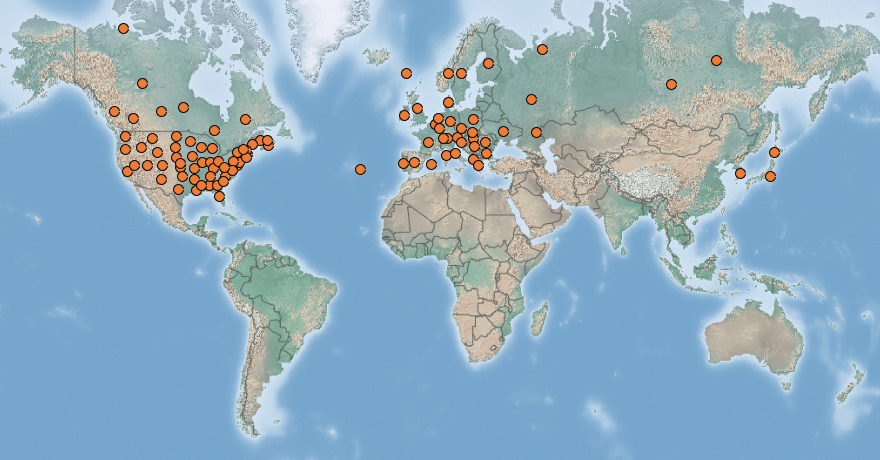 |
Tall goldenrod | Status LU: established. 1st record: LU & ITW 1882. |
 |
Riseg Goldrutt | Status Eur.: established. 1st record: ~1750.1 |
 |
Verge d’or géante | RA: ISEIA: A2, Black List. Harmonia+: 0,26. |
 |
Riesen-Goldrute | Wikipedia:     | Wikispecies: | Wikispecies:  | CABI | CABI |
 |
Late guldenroede | Back to the list of neophytes |
Contents
Report the species
→ Report Solidago gigantea to the National Museum of Natural History.
Brief description
 Solidago gigantea Ait. can grow in a wide range of soil conditions but is not shade-tolerant. The plant is found in many disturbed and nitrogen-rich sites such as ruderal areas, fallow lands, abandoned fields, river banks, etc. and also colonises humid grasslands. It can build up dense and long-lasting populations and easily outcompete native plants, including tree seedlings. Competitive ability is favoured by allelopathic interactions. Once established, the plant may remain dominant for a long period of time and often prevents natural colonisation by woody species (Branquart et al. 2010).
Solidago gigantea Ait. can grow in a wide range of soil conditions but is not shade-tolerant. The plant is found in many disturbed and nitrogen-rich sites such as ruderal areas, fallow lands, abandoned fields, river banks, etc. and also colonises humid grasslands. It can build up dense and long-lasting populations and easily outcompete native plants, including tree seedlings. Competitive ability is favoured by allelopathic interactions. Once established, the plant may remain dominant for a long period of time and often prevents natural colonisation by woody species (Branquart et al. 2010).
Status and distribution in Luxembourg
Records of Solidago gigantea Ait. in Luxembourg. Data source: Recorder-Lux, iNaturalist & GBIF, 2024-07-27.
The oldest herbarium specimen at the MNHNL was collected in 1882 by Jean Feltgen (1833-1904) in a hedge near the village of Angelsberg (Specimen № 15568, MNHNL 2000-). This specimen was labeled Solidago canadensis L. and later verified as Solidago gigantea var. serotina (O. Kunze) Cronq.
The next oldest herbarium specimen at the MNHNL was collected under its synonym Solidago serotina Ait. on 1887-09-08 by Jean Feltgen (1833-1904) in a garden (“jardin Bosseler”) in Mersch (Specimen № 15601, MNHNL 2000-). The next record is a herbarium specimen collected by Jos Witry on 15 July 1937 in gardens in Rumelange (Specimen № 50850, MNHNL 2000-).
Léopold Reichling (1921-2009) reported the species on 1960-09-22 in several locations of the Grund district in Luxembourg City (Bock, Stierchen, Breedewee) (MNHNL 2000-).
Currently, 78 records of tall goldenrod are accessible through the MNHNL-mdata portal (MNHNL, iNaturalist & GBIF 2019).
This melliferous species native to North America is naturalised in Europe: fairly common to fairly rare, present in waterfronts, forest edges, wastelands, wastelands; often in large stands (Lambinon & Verloove 2012: 703).
This species includes populations in North America with variable chromosome numbers. Naturalised plants in Europe have generally been reported to Solidago gigantea subsp. serotina (O. Kuntze) McNeill, still known to be tetraploid. The question remains, however, whether Solidago gigantea subsp. gigantea, diploid, also exists in Europe, and especially whether the two taxa are morphologically identifiable. The problem remains to be studied in the wild (Lambinon & Verloove 2012: 703).
Risk assessment
ISEIA protocol
A2 (3+2+3+3) = Black List (Ries et al. 2013: 19).
Harmonia+ protocol
Overall risk score 0,20 = (Overall Invasion score 0,63 x Overall Impact score 0,42) (Ries et al. 2020).
 Invasion
Invasion0,42

 Impact
Impact0,20

 Risk
RiskWorldwide distribution
Bibliography
- Branquart, E., S. Vanderhoeven, W. Van Landuyt, F. Van Rossum & F. Verloove, 2010. Harmonia database: Solidago gigantea Harmonia version 1.2, Belgian Forum on Invasive Species. URL: http://ias.biodiversity.be [accessed on 2019-10-15]
- CABI, 2019. Solidago gigantea. In: Invasive Species Compendium. Wallingford, UK: CAB International. URL: www.cabi.org/isc [accessed 2020-03-04]
- Lambinon J. & F. Verloove, 2012. Nouvelle flore de la Belgique, du grand-duché de Luxembourg, du Nord de la France et des régions voisines. Sixième édition. Avec la collaboration de L. Delvosalle, B. Toussaint, D. Geerinck, I. Hoste, F. Van Rossum, B. Cornier, R. Schumacker, A. Vanderpoorten et H. Vannerom. Jardin botanique national de Belgique, Meise. CXXXIX + 1195 pp. ISBN : 9789072619884.
- MNHNL, 2000-. Solidago gigantea Aiton in Recorder-Lux, database on the natural heritage of the Grand Duchy of Luxembourg. Musée national d’histoire naturelle, Luxembourg. URL: https://mdata.mnhn.lu [Accessed 2019-10-15]
- MNHNL, iNaturalist & GBIF, 2019. Solidago gigantea Aiton in MNHNL-mdata, online portal combining species observation from Recorder-Lux, iNaturalist and GBIF. National Museum of Natural History, Luxembourg. URL: https://mdata.mnhn.lu [Accessed 2019-10-15]
- Ries, C. & Y. Krippel, 2021. First records of 56 invasive alien vascular plants in Luxembourg. Bulletin de la Société des naturalistes luxembourgeois 123: 115-127. [PDF 241 KB]
- Ries, C., Y. Krippel & M. Pfeiffenschneider, 2020. Risk assessment after the Harmonia+ protocol of invasive alien vascular plant species in Luxembourg. Bull. Soc. Nat. luxemb. 122: 197-205. [PDF 132 KB]
- Ries, C., Y. Krippel, M. Pfeiffenschneider & S. Schneider, 2013. Environmental impact assessment and black, watch and alert list classification after the ISEIA Protocol of non-native vascular plant species in Luxembourg. Bull. Soc. Nat. luxemb. 114: 15-21. [PDF 652 KB]
Suggested citation of this webpage
Ries, C., M. Pfeiffenschneider & Y. Krippel (Eds.), 2024. Solidago gigantea Ait. In: neobiota.lu - Invasive Alien Species in Luxembourg. National Museum of Natural History, Luxembourg. URL: https://neobiota.lu/solidago-gigantea/ [Accessed 2024-07-27].
Page content last updated on 2021-09-06. Last proofread by Caroline Grounds on 2019-11-21.
- Cf. CABI 2019.[↩]


